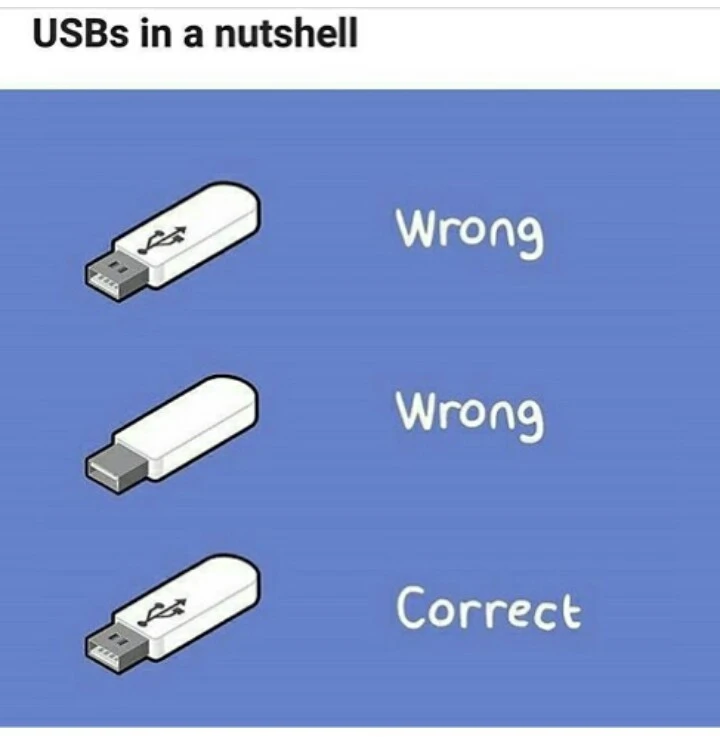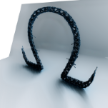Well, except all the legacy symbols on devices older than current gen.
My laptop has two USBC ports. No logos of any kind. They are Thunderbolt 4. ¯_(ツ)_/¯
If you’re trying to get Lemmy to print the backslash, you need to make it a double backslash since backslash is an “escape” character that means “ignore any special formatting meaning of the next character” (among other meanings)
Reddit was the same exact way. I don’t know how people are messing it up here too.
Here, you’ve lost an arm: \
The standard might be complicated if you want the specifics, but for everyday use it’s incredibly simple, and I love it. The number of times I needed this information is 1, even though most of my devices, including an external monitor, are USB-C.
Yeah. I grew up in the days of serial ports and parallel ports, and USB in general is so much better for most purposes. (I recall plugging my first mouse into the serial port…but wait! Where will my Hayes Smartmodem modem plug into then? Also, don’t plug and unplug things from the serial port while the computer is running.)
And USB-C is even better. My tablet needs a charge? Well my laptop charger is right here… My phone is low and needs a quick charge? Well my USB-C tablet charger will give it a decent boost very quickly. No worries about getting it plugged in the wrong way, either.
I have a docking station for my work laptop, so when I had to replace my personal laptop, a laptop that supported USB-C power delivery was mandatory. I don’t use it with the docking station very often, but knowing I can without an issue is great. My wife also has a Macbook that works on the docking station, too, in case she ever wants to use my dual monitor setup. All three laptops, from three different brands, are just plug in and go.
I can’t imagine how you think it’s incredibly simple. These things are hell to explain to pretty much any normal person who needs to know why there’s no picture on the monitor or why their laptop/phone is not charging, or why the keyboard isn’t working in BIOS (no USB 3 support so you gotta switch to a USB 2 port). Add to that the combinatorial complexity of different cables and hubs supporting different things, and no tools for troubleshooting what feature is missing (and where in the chain) or what is suboptimal.
Worse, sometimes it’s my boss who thinks they can cheap out and get a USBC dock instead of a proper dock, forcing me to run at non-native lower resolutions or unable to use a second screen.
You won’t find these symbols on most devices though (certainly not on any macbook as the picture suggests).
With some devices, I assume that they’re trying to save a bit of money.
With the MBP, I’m pretty sure that they just don’t want to disrupt the designer’s vision of the aesthetic.
I didn’t take the image to be showing a macbook, it could just as easily be my computer or probably many others.
It could be, but combine the color looking very much like Apple’s space grey, the slimness of it, particularly how slim the lid is versus the body, and what looks like the MacBook’s classic black, rounded rubber stoppers on the bottom, I think it’s safe to say that’s meant to be an MacBook.
By removing the symbols they were able to shave the case down 0.0003nm, making it the thinnest and lightest laptop ever.
How brave!
You know it’s a thunderbolt connection on a MacBook. They stopped using the USB symbol when they used the usb for thunderbolt and stopped using the mini display port.
Courage!
Stunning and brave!
If they etched the symbol they could have reduced the weight of the laptop by 0.003g making it even better
But if they omit the symbol entirely, they save 0.003 cents per unit, but they will continue to charge the same inflated retail price for it and all their cult members will cover for them by gushing about how sleek the “minimalist” design is.
Why would you need them on a MacBook? They’re always Thunderbolt.
No they aren’t. Only some are.
The only devices that don’t have at least Thunderbolt 3 on all ports do use the Thunderbolt logo on the ones that support it, except the short-lived 12-inch MacBook (non-Pro, non-Air). Basically, for data transfer:
- If it’s a 12-inch MacBook, the single USB-C port doesn’t support Thunderbolt, and only supports USB 3.1 Gen 1.
- In all other devices, if the ports are unmarked, they all support Thunderbolt 3 or higher
- If the ports are marked with Thunderbolt symbols, those ports support Thunderbolt but the unmarked ports on the same computer don’t.
For power delivery, every USB-C port in every Apple laptop supports at least first generation USB-PD.
For display, every USB-C port in every Apple laptop (and maybe even the desktops) supports DisplayPort alt mode.
It’s annoying but not actually that hard to remember in the wild.
Okay, the old ones that apparently have both do have the Thunderbolt symbol on the ones that are, though, so what’s the problem?
True, my latest Dell laptop has 3 “usb-c shaped ports”, there is 0 symbol anywhere close to them or the underside cover, you’re on your own as to what it supports, you have to find the doc online somewhere I guess.
I discovered that my Thinkpad apparently supports charging from all of the (unlabeled) USB-C ports after I inadvertently started it charging from my cell phone’s (unlabled) USB-C port.
I can do you one better: My GPD laptop has a charging indicator on the center type-C port indicating that this is where the power supply goes, but it can actually be charged from either port regardless of the icon. Both ports are USB 3.0 or 3.2 or whatever the current fast standard is this week, but only the center one supports video out via an external GPU enclosure. So if you want to use it docked with an eGPU, it’s actually required to not plug the power supply into the port that says you should plug the power supply into it.
So not only is the marking meaningless, it’s arguably worse than meaningless because in one of the headline hardware setups for the machine it is actually 100% incorrect to do what the marking is telling you to do. Wrap your head around that one…
Tbf my work Dell Latitude 5440 has a USB A with a SS5, an A with a SS5 and charging indicator, a C with a thunderbolt indicator, and a C with a battery and a thunderbolt indicator.
So at least some of their laptops do in fact have the indicators similar-ish enough to what the infographic shows.
my 5680 has absolutely nothing. Checking online I found that the right one is a usb-c 3.2 and the 2 left ones are TB4. IIRC they all support DisplayPort and all support being used as the power input (165W charger), not sure for PD and fast charging a cell/tablet…
Have the thunderbolt symbol on my HP Laptop.
It gets even better, each function of the port also needs proper support from the cable. Often cables do not support the full spec of usb to cut costs.
While the symbols in the post are often put on computers, for usb cables this is seldom done (only a few brands do).
Source: had to find a cable that supports both DP and PD to connect a portable external monitor after I lost the original cable. (1/9 cables worked)
Luckily, all new PC seem to choose Thunderbolt over only alt mode, which makes stuff more easy, since they have the flash on the cable (but are also more extensive, I gear
Sometimes people want to charge their phone in an outlet 10 feet from their airport seat.
Sometimes people want to transmit 8k video.
It’s not physically possible to do both tasks with the same cable.
But because USB is a flexible standard, we don’t have two incompatible specs to do the same thing. So when you get out of the airport and to your meeting, you can actually plug your phone into the meeting room projector for your business presentation. That’s a win.
Yes, this is incredibly annoying and it’s also the reason why some USB cables cost more than others, even they may look the same superficially.
One of those cables that don’t work is rated for like 120W, with gigabit transfer speed… But it refuses to transmit display… Like bruh
1080p at 60 Hz is 4.4 gigabit
Didn’t really think about that one but you’re right damn… (Looked it up, and it depends on the bit depth etc, but it’s around 3.2Gbps for the display settings if I’m correct)… So that explains a lot
USB-C video is usually DisplayPort Alt Mode, which uses a completely different data rate and protocol from USB.
Even using old 2016 hardware, a computer and USB-C cable that both only support 5 Gbps USB (such as USB 3.1 Gen 1) can often easily transmit an uncompressed 4K 60Hz video stream over that cable, using about 15.7Gbps of DisplayPort 1.2 bandwidth. Could go far higher than that with DP 2.0.
Some less common video-over-USB devices/docks use DisplayLink instead, which is indeed contained within USB packets and bound by the USB data rate, but it uses lossy compression so those uncompressed numbers aren’t directly comparable.
That sounds like a dedicated charging cable. So yeah, they will (if at all) only transfer data slowly and not support any extras features like displayport.
A dedicated charging cable wouldn’t have “gigabit speed”
No USB cable has “gigabit speed”. It probably has 480 Mbps (USB 2.0 standard).
Maybe he meant a 5 Gbps Gen1 cable. That would be “gigabit speed” but still rather slow by today’s standards and won’t support DP. They are pretty cheap these days, so wouldn’t be suprising to see left over stocks being sold as charging cables.
No USB cable has “gigabit speed”. It probably has 480 Mbps (USB 2.0 standard).
What? I’m either misunderstanding you or this statement isn’t correct. Having USB cables that can move data at gigabit rates has been common for quite some years.
Here’s the latest stuff:
https://en.wikipedia.org/wiki/USB4
Bitrate
20 Gbit/s
40 Gbit/s
80 Gbit/s
120/40 Gbit/s asymmetricWhat? I’m either misunderstanding you or this statement isn’t correct
I meant that no USB standard actually has exactly 1 Gbit/s. I even mention that next one if 5Gbit/s. Just a misunderstanding I think.
Yeah, it’s gotten so bad I eventually ordered a USB cable checker to figure out what any given USB cable is capable of (and to see if the cable has gone flaky, which seems to happen a lot). I haven’t received it yet so I don’t know if I can recommend this item, but … gosh darn you sure need something like this.
For that portable monitor, you should just need a cable with USB-C plugs on both ends which supports USB 3.0+ (could be branded as SuperSpeed, 5Gbps, etc). Nothing more complicated than that.
The baseline for a cable with USB-C on both ends should be PD up to 60W (3A) and data transfers at USB 2.0 (480Mbps) speeds.
Most cables stick with that baseline because it’s enough to charge phones and most people won’t use USB-C cables for anything else. Omitting the extra capabilities lets cables be not only cheaper but also longer and thinner.
DisplayPort support uses the same extra data pins that are needed for USB 3.0 data transfers, so in terms of cable support they should be equivalent. There also exist higher-power cables rated for 100W or 240W but there’s no way a portable monitor would need that.
ai generated lol
What’s AI generated?
Me. Sigh.
It’s useful but it got me even more lost 😅
So many different standards my god.
I just love that in a world with Power Delivery (PD) they decided that the best way to indicate Display Port (DP) was to have an ambiguous symbol involving a P and a D.
Also, giving anything the initials “DP” is weird and creepy as fuck, given that “DP” was already a well-established acronym in the porn industry years before DisplayPort was even conceptualized.
person with the initials DP has left the chat crying
If you’re going to forbid any 2-letter initialism because it might have naughty connotations, you’re not going to be left with many options.
Dungeon Party
Given that there are engineers involved I wouldn’t be at all surprised if that was deliberate. Trying to get potentially offensive or otherwise NSFW acronyms past marketing without them noticing is practically an industry-wide joke at this point, which is why they are so prevalent in the FOSS space. (no marketing staff to complain)
If that’s true in this case, though, hats off to whoever managed to get it though to official commercial standards
I like how they (seem to) try to get away from Latin alphabet, just to go with DP for display port.
The P and D symbol is the DisplayPort logo. I’m not sure when it was first used, but the DisplayPort standard itself is quite a bit older than USB Power Delivery.
It’s still confusing though regardless of which can lay the best claim to the letters P and D. I would have suggested Power Delivery could use some sort of lightning bolt symbol, but then I realised that would probably conflict with Thunderbolt, which also uses USB-C.
It’s almost as if having all these different features would be easier to differentiate if they had different physical shapes.
How about a monitor/TV for display.
I like that battery for power, though a vertical battery would be clearer.
Yeah, Display Port is old, but I’ve never seen that P and D symbol before, or at least never noticed it. And, even if it existed before Display Port over USB, you’d think that that potential confusion was a good opportunity to come up with a new logo for something that would be put next to a USB port.
It’s almost as if having all these different features would be easier to differentiate if they had different physical shapes.
I think the goal was always that you’d only ever need one type of port and one type of cable and that that port and cable could do anything. Unfortunately, because there are so many revisions and so many features are optional, you’ve now got a situation where the port is the right shape, the cable fits into the port, but you can’t get the thing to work without reading the fine print, or without decoding obscure logos.
You’ll want to run USB PD, not to be confused with the USB “P” and “D” label which refers to DisplayPort, not to be confused with some other ways of transporting DisplayPort over USB. And you’ll want charging support, so look for the USB lightning bolt that means “USB charging”, not to be confused as the different USB lightning bolt that means “Thunderbolt”, which isn’t the same thing as the Lightning connector that is about the same size as the USB-C connector and was used in a similar role on various devices.
Piece of cake.
DisplayPort not to be confused with display port, when someone asks you for a “display port cable” and you start going to pick one of VGA/HDMI/DVI cables instead.
exactly hahaaaaaa thought of this
All they had to do was require stamped icons on the ends of the plugs in the spec, and instead we have the current cable mystery clusterfuck 🤦
USB in 1996: Let’s make one connector that handles everything
USB in 2024: Let’s make one connector do thirty different incompatible combinations of things
USB in 1996: lets let you plug any device into the back of your computer.
USB in 2024: phones, tablets laptops are going to charge at crazy voltages and we’re going to show you 8k video all over the same port and you can insert it in both directions and we’re still going to connect any device to any device.
To be fair, the goal is the same.
- Not everyone needs the sheer CPU, power, and costs of a 40 GB/s connection.
- Higher wattage chargers cost more
- Not everyone needs a USB port that does video out (even if it should be standard now that virtually every new GPU should be compatible)
- Even if the CPU and GPU support a feature, the OEM can use a cheaper controller
- The controller firmware can lack support for a feature or be buggy
The USB forum can only solve points 4 and 5 without raising costs on the cheapest hardware.
While USB is now needlessly complicated and poorly labeled for consumer understanding, at least it succeeds in being backwards compatible so long as the physical connectors match (and all you need is a dumb adapter to convert any connector). If you have a 3.0 port on one device, a 2.0 port on the other device, and a 3.1 cable, you get 2.0 transfer speeds.
HDMI has the same kind of “issue”. Whatever the specs on each component, throughput and features drop to the lowest common denominator when in use.
If you have a 3.0 port on one device, a 2.0 port on the other device, and a 3.1 cable, you get 2.0 transfer speeds.
USB ports are not labeled with numbers. You just made up numbers to name several different things.
This is why you think things are “poorly labled”. Your headcannon is broken, not the labeling.
USB keeps changing their own standard every 2 years why bother learning it.
I mean, they update the standard to add new things. Is that bad?
They also change existing terms for no good reason.
The don’t.
But give me an example of what you’re talking about. I’ll explain.
USB3.2 gen 2, USB3.2 Gen2x2
The consumer facing names for those transmission specs are and have always been:
-
SuperSpeed 10 Gbps
-
SuperSpeed 20 Gbps
Unless you’re designing your own circuits you don’t need to worry about signaling rates (ie “Gen”) or lane configuration (Z×Y).
-
Pshh, speak for yourself. I’m ready for USB 3.2 gen 5 pro ultra max
Was that the first one that had M Bison as a playable character?
And Knuckles
We’re not calling it that anymore. It’s been rebranded to “SuperDuper Speed USB ]|[” now. Note that this is a different standard than the previous “SuperDuper Speed USB 3,” and under no circumstances should you call it “SuperDuper Speed USB 3.0,” because there was never any such spec and pedantic nerds will climb up your nose in the comments if you ever utter it.
But will that be better or worse than USB 3.3 gen 2 extra super speed?
Both, of course.
Will USB 3 get an update now USB4 is out?
Eh, USB4 is basically what USB 3.3 would’ve been, but with fresh branding. I expect it to have the same naming issues after a few updates…
Wasn’t USB4 based on Thunderbolt 3?
Sort of? It borrows a lot of the high speed protocol bits from Thunderbolt 3, but I think it does DP a little differently (at least it supports different DP standards than TB3). So it’s closely related, but not necessarily the same thing.
white P inside a black D
I’ve never seen the one enclosed in a battery, but I’ve seen the rest.
What is the difference between USA and USB?
One connects to all your devices and accesses your data, the other is a hardware standard.
One gives you power, the other does everything it can to make sure you never do.
OIL
I think that maybe having two similar lightning bolt symbols that mean different things wasn’t the best design decision that the USB guys could have made.
The ‘Thunderbolt’ symbol is Intel’s proprietary technology. Apple and Intel made it. First apple registered Thunderbolt as a trademark but later they transferred it to Intel. The lightning bolt icon which supports fast charging phones or other devices when connected to the laptop is different and developed by the USB guys.
One should not that though Thunderbolt over USB-C offers the same speed and connectivity as a native thunderbolt cable, the native cable can be 40m long whereas the USB-C implementation is max 2m
Things are muddied a bit though because USB 4 has built in support for thunderbolt
Everything defined in the Thunderbolt 3 spec was incorporated into the USB 4 spec, so Thunderbolt 3 and USB 4 should be basically identical. In reality the two standards are enforced by different certification bodies, so some hardware manufacturers can’t really market their compliance with one or the other standard until they get that certification. Framework’s laptops dealt with that for a while, where they represented that their ports supported certain specs that were basically identical to the USB 4 spec or even the Thunderbolt 4 spec, but couldn’t say so until after units had already been shipping.
best design decision that the USB guys could have made
lol the whole history of usb is full of design fuckyous

USB-A: the 4 dimensional port.
I mean, they fixed that with USB-C (after introducing one small USB port, mini-USB, that wasn’t reversible, with the tensioners that wear out on the expensive (device) side and and then introducing micro-USB which fixed the tensioners but still wasn’t reversible).
I’d personally kind of like to have magnetic breakaway connectors or similar so that I can’t damage devices if they fall, especially given that micro-USB and USB-C aren’t the most-physically-robust of connectors. Adapters with proprietary ways to do this exist:
https://www.amazon.com/MoKo-Magnetic-Adapter-Straight-Thunderbolt/dp/B0CGLM6PYN
But they aren’t part of the USB spec. If they ever switch to something like that, we’re gonna have another phase of incompatibility.
Brother, now that thunderbolt 4 has been introduced it’s even more confusing. Some of these labels are already out of date















